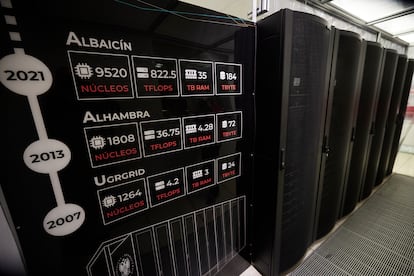A new supercomputer takes 24 hours to do operations that required 25 years
Dubbed ‘Albaicín’ and housed in Spain, the machine allows for more complex models and will help researchers in a range of sectors including nanotechnology

Research today depends to a large degree on the capacity to carry out computationally intensive processes and simulations that have been beyond the limits of normal computers for some time. Science requires supercomputers that are, in fact, powerful computing infrastructures in a network of hundreds of nuclei working at the same time and carrying out simultaneous operations at a vertiginous speed. The University of Granada (UGR), in Spain’s southern Andalusia region, on Tuesday launched a new supercomputer called Albaícin, which has a massive 822 teraflops of processing power – a teraflop is the equivalent of one trillion calculations per second. According to the university’s rector, Pilar Aranda, this supercomputer will be available to the more than 125 research groups and 500 scientists at UGR and other public universities in Andalusia.
The new supercomputer, which required investment of more than €1.2 million ($1.36 million), is going to allow the scientific community not only to significantly reduce the waiting times in research, but also to broaden into fields of investigation that until now have been off-limits to the UGR as they required mass data processing. “We will reach sectors that before would have been impossible for us,” said Aranda on Tuesday. “And not just UGR, but other Andalusian universities as well, as we want to be an example of university collaboration.”
Albaícin, however, is not the first supercomputer to come out of UGR. According to Begoña del Pino Prieto, a professor of architecture and computer technology, the university made its first foray into supercomputing 30 years ago.
Indeed Albaícin is actually UGR’s third supercomputer. But technology has advanced very far since the university’s first projects, and this has led to a significant increase in processing power. Albaícin is 200 times faster than UGR’s first supercomputer, which was launched in 2007, and 20 times faster than its second, which came out in 2013.
“The 9,520 nuclei are capable of reducing in just 24 hours highly complex scientific processes that could have taken 25 years to complete,” explained Jesús Rodríguez Puga, the computer head of Systems Investigation and Supercomputing at UGR, in reference to Albaícin’s processing power.

Blanca Biel, a researcher of molecular and nuclear atomic physics at UGR, said that her work in nanotechnology will benefit greatly from the new supercomputer. She explained: “[Nanotechnology], which is based in large part on simulations of materials on the atomic scale, requires very complex calculations that can only be done on powerful machines which up until now took three or four weeks to do, and that, with Albaicín, will be able to be completed in less than a day give or take.”
Speaking on Tuesday, Begoña del Pino described supercomputing as “a decisive element to promote investigation, innovation, high-level [knowledge] transfer and specialized training, which are strategic focuses for UGR.”
Enrique Herrera, deputy rector of Research and Transfer, who is a highly cited researcher on computing, said that “there is no high-level investigation without research infrastructure that increases computing power and the resolution of processes and complex simulations.”
Herrera believes that this new supercomputer will allow UGR to take on its strategic goals such as turning Granada and the university into the headquarters of Spain’s National Regulatory Agency on Artificial Intelligence. With Albaicín, the university not only hopes to help national research groups, but also “to provide computing solutions for specific problems in society,” he said. Herrera added that the university also, in time, wants to extend its supercomputing services to companies and public institutions that require this level of computing power.
Tu suscripción se está usando en otro dispositivo
¿Quieres añadir otro usuario a tu suscripción?
Si continúas leyendo en este dispositivo, no se podrá leer en el otro.
FlechaTu suscripción se está usando en otro dispositivo y solo puedes acceder a EL PAÍS desde un dispositivo a la vez.
Si quieres compartir tu cuenta, cambia tu suscripción a la modalidad Premium, así podrás añadir otro usuario. Cada uno accederá con su propia cuenta de email, lo que os permitirá personalizar vuestra experiencia en EL PAÍS.
¿Tienes una suscripción de empresa? Accede aquí para contratar más cuentas.
En el caso de no saber quién está usando tu cuenta, te recomendamos cambiar tu contraseña aquí.
Si decides continuar compartiendo tu cuenta, este mensaje se mostrará en tu dispositivo y en el de la otra persona que está usando tu cuenta de forma indefinida, afectando a tu experiencia de lectura. Puedes consultar aquí los términos y condiciones de la suscripción digital.











































